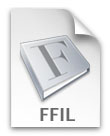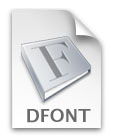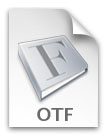Deane Nettles | Advertising & Graphic Design
FONTS FOR PRINT PROJECTS
These are notes from Harold Baldus at Phil's Fonts, my favorite font vendor, with some additions.
Warning: the following will make your brain bleed; read it to get an idea of how confusing it is out there, and read it a second time to gain some understanding.
FONTS ARE SURPRISINGLY COMPLICATED
Understanding and managing fonts is a a lot like herding cats except that it can actually be done. The price for not understanding fonts is not exactly life in hell but it feels just like it, particularly if you are either swapping files with people on other platforms or having problems caused by corrupt fonts.
EIGHT FONT TYPES
A brief history: In the beginning, Postscript fonts were created by Adobe (approx. 1982). They were so advanced over any digital type previously produced that they, in combination with the Macintosh, quickly killed the traditional typesetting industry. Truetype fonts were created by Apple for System 7 so they wouldn't have to license Adobe's technology for their operating system, then adopted Microsoft. When Truetype was release for the Mac, the early image setters couldn't read them correctly, giving Truetype a horrible reputation. Finally, Microsoft and Adobe together created Opentype, so that fonts could be used cross-platform seamlessly. Postscript and Truetype could only contain on average 256 glyphs, making it very difficult to set extended character sets and Cyrillic and Asian languages; Opentype fonts can contain up to 65,000 glyphs (characters).
So the font types you will run across on a designer's computer can include:
Truetype Fonts

-
MAC Truetype fonts with a .ttf extension and a ttf icon.
Technically they are cross-platform but really should only be used on a Mac. (Supposed to work with Mac OS 9.x, OS X, and Win anything.) - WIN Truetype fonts with a .ttf extension and a ttf icon. Technically they are cross-platform but really should only be used in Windows. (Supposedly works with Mac OS 9.x, OS X, and Win anything. The issue has to do with whether they used "Mac encoding" or "Win encoding" or "Adobe encoding" or "Unicode encoding". This is way too esoteric for almost anyone to deal with. General info on encoding is available at Mike's Sketch Pad or you can read more by downloading the FontLab manual.) The exception to this are fonts installed by the Mac OS with a .ttf extension and a description of "Windows Truetype font" — they work fine cross-platform.
Unfortunately it's next to impossible to tell the difference between a .ttf font built for a Mac and a .ttf font built for Windows by examining the file. The only way to know which one you have is if it was represented as "MAC Truetype" or "WIN Truetype" at the time of purchase or download.

- MAC Truetype fonts that are contained within a suitcase file. These files rarely have an extension and are described as a "font suitcase" with an FFIL icon. (It is quite difficult to see the difference between a suitcase containing Mac Truetype fonts and a suitcase containing Mac screen fonts that support Postscript as described in "5B" below.) MAC Truetype fonts in a suitcase will be corrupted the moment they land on a Windows machine. Unless you are sure that a Windows Truetype version is also available, Mac Truetype fonts packaged in a suitcase should only be used when you know your work will never ever need to be edited, viewed or printed in a Windows environment.
Postscript Fonts
- Mac Postscript© fonts are made up of TWO parts. They must BOTH be present in order for a Postscript font to work.

Part A.) A Postscript file that has no extension and is described as a "Postscript Type 1 outline font" with an LWFN icon.

- Windows Postscript fonts are no easier for users to understand. They are comprised of between 2 and 4 files with extensions of .pfb, .pfm, .afm and .inf. Windows really only needs a .pfb and .pfm file for each font; however, many older fonts only contain a .pfb, .afm and .inf but are lacking a .pfm file. When you use the font installer in Win 2000 and XP it will use the .afm and .inf files to automatically generate a .pfm file on the fly and place it the Windows Fonts folder along with the .pfb. (You will only see a .pfm file in the Fonts folder while the .pfb file is invisible. If you copy the .pfm file out of the Fonts folder a .pfb file will magically appear along with it.) Unfortunately the current version Windows Vista no longer automatically creates a .pfm from an .inf and .afm. This means that some older Postscript fonts will not install into Vista. Big bummer. Also, there are a few Windows programs that will not use Postscript fonts. These tend to be either very low-end programs and/or a few very high-end programs (some mailing software and some sign-making software).
Part B.) A suitcase file containing screen fonts supporting the above Postscript file(s). It usually does not have an extension but sometime can have a .suit or .bmap or .scr extension. It is described as a "suitcase font" and has an FFIL icon. These suitcases can contain screen fonts supporting more than one Postscript font. (Hence, "suitcase.")
For example: A suitcase named Berkeley may contain all eight screen fonts supporting all eight Postscript outline fonts. Without additional tools, there is no way to view or edit the contents of a font suitcase file in OS X. There is a commercial application, Font Smasher, that will allow you to view and edit font suitcases in OS X. Mac OS 9 does allow viewing and editing suitcase files but OS X running in "Classic" OS 9 does not.
Opentype Fonts
Opentype has it's complexities but it is somewhat less perplexing than Truetype or Postscript.

- Apple DFont with a .dfont extension, DFONT icon and a description of "Datafork Truetype font". These are an Apple proprietary Truetype-based Opentype format. These files will be corrupted the moment they land in Windows. Dfonts should only be used when you know your work will never need to be edited, viewed or printed in a Mac OS 9 or Windows environment.

- Opentype fonts based on Postscript technology have an .otf extension, an .otf icon and are described as "Opentype font". These are cross-platform and will work with Mac OS X, Win NT, ME, 2000 and XP. Once again, there are a few Windows programs that will not use Postscript-based Opentype (.otf) fonts. They tend to be either very low-end programs and/or a few very high-end programs (some mailing software and some sign-making software).

- Opentype fonts based on Truetype technology have a .ttf extension, a .ttf icon and are described as "Truetype font" — therefore they are virtually indistinguishable from a pure Truetype font. These are cross-platform and will work with Mac OS X, Win NT, ME, 2000 and XP. There are many fewer Opentype fonts based on Truetype than based on Postscript. Bitstream is the only major foundry who has based their Opentype library on Truetype. Microsoft and Apple also use this technology for some fonts.
Both both Postscript- and Truetype-flavored Opentype fonts work fine and you do not need to be wary of which ones you are using.
Additional Opentype information: You will sometimes see either the letters "Std" or "Pro" in an Opentype font name. (These are abbreviations for "Standard" and "Professional".) Unfortunately, "Std" and "Pro" do not have universally accepted definitions even within the same developer. Either one may contain extended character sets including additional foreign language support, alternates, swashes, small caps, old-style figures, etc. Pro fonts are more likely to have some of these extended attributes but if any of these features are important to your documents then you must check carefully before purchasing. You must also verify that your application(s) supports accessing an extended character set. The Adobe CS applications and QX 7.x support them but QX 6.x and before does not.
(For more information about the power of Opentype fonts, see An Introduction to Opentype Substitution Features in ilovetypography.com. Interestingly, the coding for advanced font features seems very similar to coding for css.)
Application support for pure Postscript and perhaps pure Truetype will eventually go away. Both Postscript-based Opentype (.otf) and Truetype-based Opentype (.ttf) are the future. Unless you use applications that ONLY recognize Truetype fonts or ONLY work in Mac OS 9, purchase either Opentype format if they are available. For users of applications that only recognize Truetype then you must purchase either Truetype-base Opentype or pure Truetype fonts and this will limit your choices. Also note that there are still thousands of fonts that are simply not available in Opentype.
More info: http://www.adobe.com/type/opentype/
ADDENDUM: According to Harold, Apple wasn't going to provide support to non-Opentype Postscript fonts in Snow Leopard. Consider this a warning, and make it a point to buy only Opentype fonts. Also, Apple made a change in how it handles font metrics in the original release of Show Leopard, causing text reflows in iWork products and Quark that it didn't fix until update #3 — proof that it's not a good idea to install the first release of system upgrades.
ACCESSORY FONT SOFTWARE
Font Managers
The three main commercial applications to assist users are Font Agent Pro, Suitcase Fusion, and Linotype Font Explorer. They have learning curves and are not without problems but are still recommended over Apple's Fontbook. (And if you use them, remember to delete Fontbook from your system, so they don't conflict.)
One reason to use these programs is to turn off fonts you aren't using, so you spend less time scrolling through huge lists of fonts to get to the ten you always use. They also have varying abilities to categorize fonts, and to have them turn on and off as you close and open files and programs. You may also be able to use them to turn off system fonts you can't otherwise control.
Font Repair Applications
Before loading your old fonts into your new system, you should run a program like Font Doctor on them—which also has a learning curve—in order to prevent corrupt fonts from entering your workflow and creating havoc (programs crashing unexpectedly, files mysteriously not printing, etc.). Font Doctor is not foolproof, but will help. Remember to back up a copy of your font folder before running it, in case you've set the preferences wrong.
Font Editors
The most reasonably-priced font editor is TypeTool 3. It's good for creating/altering a few characters when your font doesn't look like you want, adjusting really bad kerning pairs, and saving fonts to other formats (like converting all your fonts to Opentype.) I've also found it useful for repairing broken fonts. Just remember to work on a copy of the font, not the original. Its maker, Fontlab, also distributes several other higher-end font editors.
Cache Cleaning
Occasionally your font caches in your Mac system can become corrupt, causing incorrect font display (most notably in Safari and Mail) and they need to be cleaned out. Several utilities can do this, among them the free utility OnyX and the shareware utility Cache Cleaner.
FONT ETHICS
Long before MP3s were being passed around, fonts were king of rip-off hill. If you think making music is difficult then try creating a typeface. A single individual good quality font will take several months, if not a year of tedious, compulsive labor and their creators should be compensated. Also, it is unfair to those designers who paid for fonts to compete with those who steal them.
- Consider and include font purchases when estimating and billing jobs.
- Fonts usually come with a 1-to-5 user license for use on 1-to-5 computers at one company, school or household. That's the total workstations you can use them on; if you want to use them on more computers, you need to buy a larger license. (Sometimes different resellers have different licenses for the same fonts — it pays to ask.)
- It is both unethical and illegal to distribute commercial fonts beyond the licensee without paying to do so. In other words, do not send fonts YOUR company owns to your clients when your clients ask for a copy of their project; your client is not covered by your company's license. (You are allowed to send fonts to your commercial printer; they are legally bound to use them only to print your job.) If the client must have the fonts, include the purchase of a set of fonts for your client in your estimate, buy them for them and have them shipped to them. You may find your company's owners and account executives resist this, but you are in fact legally protecting your company from distributing stolen software, and your client from possessing stolen software.
- And don't swipe fonts for yourself — charge enough for your work to buy them.
FREE FONTS
Free fonts are another matter. Keep in mind that many "free" and cheap ($2–$3) fonts are often ripped-off commercial fonts, run through a grinder and then renamed. Avoid downloading those when possible. And remember, even free fonts can come with a license. It is not uncommon for them to allow "personal" use while disallowing "commercial" use, so read the license. Having said that...
If you download a free font you must test it thoroughly before putting your job and client on the line. Use it in Illustrator and set each character, then make a PDF (preferably a pdf x-1a) to verify that it functions properly. After that, use Illustrator's "create outlines" command to make sure it functions properly. Also, make sure that the font appears in the font menus of the applications you'll be using. These three tests can prevent severe hair pulling and job loss. They are a small price to pay in order to use a "free" font.
— Harold Baldus, Phil's Fonts, www.philsfonts.com
[And just because a free font is in Opentype format does not mean it will not have problems. I've run across free Opentype fonts with incorrect metrics that won't open or pretend to open but don't show up in your programs. — DN]
FONTS UNDER SYSTEM X
If you want to control your fonts under System X on the Mac, here is an exhaustive (in both senses of the term) primer on fonts and font locations: Font Management in OS X, by Kurt Lang
